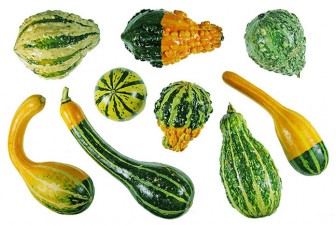Ornamental gourds can be very exciting plants to grow nowadays, and can result in the most amazing shapes and sizes. The regular size of gourd was very popular in biblical times, and even now in parts of Africa the common gourd has been used for carrying water for thousands of years, when the ornamental gourds were not known. These modern and very attractive plants have not been with us for many years and have resulted from careful selection and crossing between members of the great family, the Cucurbitaceae.
In the United States and in Europe a packet of ornamental gourd seed will cost very little, but the value in terms of range of shapes and sizes and colours of the fruit is tremendous. The fruit can be used for decoration throughout the home, and lasts and lasts and lasts. Nothing needs to be done to them except perhaps to give them the occasional dusting. I suppose it might be possible to apply a coat of varnish if you are really keen on preservation.

The top of Roraima isn’t a great place for plants in terms of available water. I can truthfully say that Sir Arthur Conan Doyle’s ‘Lost World’ is no picnic area. Not the place for a nice weekend away from the children. Constant rain washes away all the nutrients from the top, and the result is a plant population that exists rather than thrives. The food supply is so poor or non-existent that many plants have had to find other ways to survive, and have to hunt for it. No Miracle Gro for them.

Many have become carnivores, including sundews, bladderworts, and pitcher plants, and all depend on a supply of insects to survive on Roraima. The sundews catch flies and mosquitoes on sticky leaf like pads and absorb them. The bladderworts suck them into little bladders which open when water pressure changes occur, and then dissolve them. The blue-flowered Roraima bladderwort (Utricularia humboltii) actually spends its entire life in the watery urn of a bromeliad, sending out long arching shoots in search of the next bromeliad to give it a home and food supply. This single plant will colonize dozens of square yards of bromeliads in order to keep itself supplied with food.
The pitcher plant Heliamphora nutans which is endemic to Roraima (only found there) has downward pointing hairs below its slippery waxy lip which prevent insects climbing out once they have slipped in. The resultant soup is gradually absorbed by the plants. With the temperature in the 40oF range, constant rain and cloud it is one of the slimiest, wettest and most inhospitable places on earth. Water shortage is unknown there, but the further away one gets from Roraima the more seasons start to exert an influence. Thank heavens you don’t have as much water as Roraima and what you do have can be conserved by good management of your soil and water reserves. Take care wherever you are.





